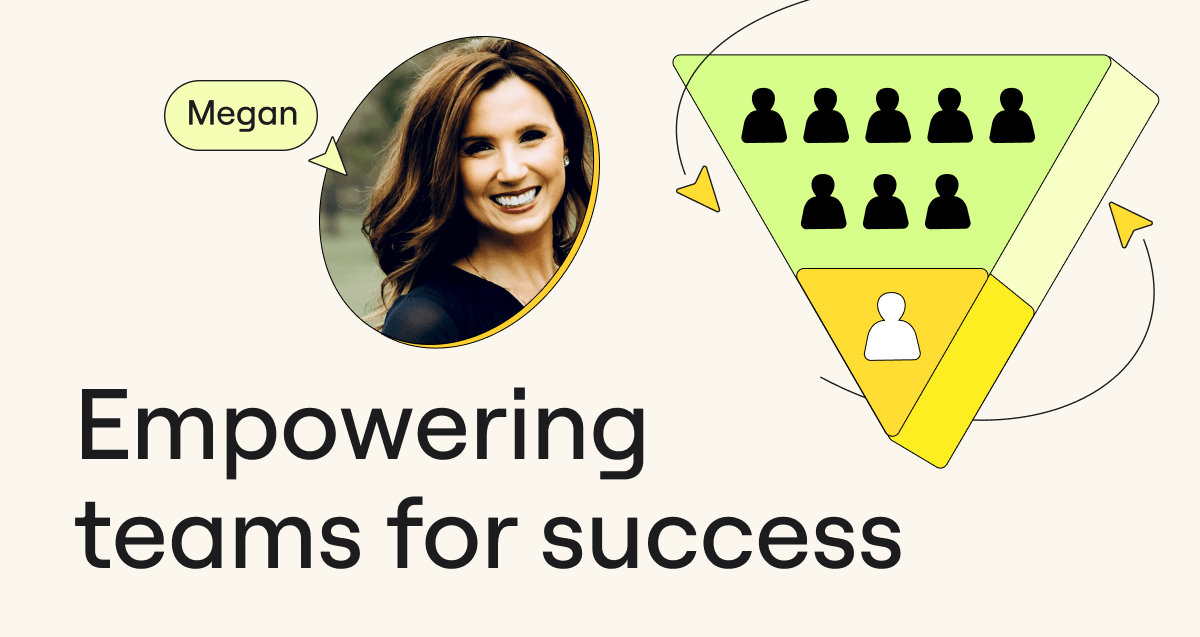At Miro, one of our core behaviors is to “empower each other” – we trust and hold each other accountable to achieve great outcomes. This is reflected in the way we work together as team members, but also the approach we take to leadership.
For me, I’ve found that throughout my career and at Miro, flipping the traditional leadership hierarchy is a powerful way to help you and your team grow. This philosophy, often referred to as servant leadership, is my guiding principle for how I approach leading teams. Today I’ll share more about it, how I use it in my role at Miro, and how it’s helped me become a better leader.
I’m Megan. I’m the Head of Global Business Recruiting at Miro. I’ve worked in a leadership position for 7 years, leading teams as small as 5 and as large as 20. I currently lead a distributed team of recruiters spread across the globe.
Let’s start with a definition.
Servant leadership: The inverted triangle
When I think of traditional leadership structures, I imagine a triangle. Conventional leadership often positions the leader at the top, expecting the team to support and elevate them. Servant leadership flips this perspective on its head. In this philosophy, the leader positions their team at the top, prioritizing their growth and well-being. The leader here becomes a supportive foundation, enabling their team to thrive.
As a leader I’ve seen that with this approach, if my people are being developed, listened to, feel like their career goals are being supported, and the expectations of their role are clear, then they are enabled to do their best work. As a result, I have found that this inevitably impacts overall team engagement.
So, for me, it’s far more rewarding and achieves far better results to be a servant leader. In order to be successful at this philosophy, I have two practices that I follow in my role at Miro – radical candor and situational leadership. Let me take you through how I use them.
Radical candor: the power of feedback and relationship building
At the core of servant leadership is effective communication, and radical candor plays a pivotal role in this aspect. Radical candor is a style of communication that emphasizes both caring personally and challenging directly. Instead of shying away from feedback or giving vague praise, leaders practicing radical candor provide specific, constructive feedback that helps team members improve.
It’s communication that helps to ensure that progress is clear, relationship building is clear, and career development and performance is clear. This is a daily form of communication, not something used only at performance reviews twice a year.
The four quadrants of radical candor
Radical candor is made up of four quadrants with different communication approaches:
- Ruinous Empathy: When leaders care personally but avoid providing critical feedback, hindering growth and improvement.
- Manipulative Insincerity: A toxic approach where leaders give false praise but criticize their team members behind their backs.
- Obnoxious Aggression: A direct, harsh approach that lacks personal care and undermines team morale.
- Radical Candor: The ideal quadrant where leaders care personally about their team and challenge them directly to achieve their best performance.
How to use radical candor to give feedback
Let’s imagine a scenario where a leader communicates according to all four quadrants.
A member of your team was leading a presentation to a group of important stakeholders. The presentation ran too long, forcing them to rush and leaving no time for questions or feedback at the end.
The leader would say:
- Ruinous Empathy: “Great job on that presentation, everything went great.”
- Manipulative Insincerity: To the team member, “Great job on that presentation!” To fellow managers, “They really messed up the presentation, they obviously didn’t practice at all.”
- Obnoxious Aggression: “You literally didn’t have enough time. Did you even practice this at all?”
- Radical Candor: “Really great job on your presentation. You were clearly prepared, you put a lot of time into the content, the content was applicable. I really liked when you described X, Y, Z. I think next time it would be beneficial for you to do a dry run so that you don’t go overtime and you’re able to get questions and feedback during the actual call. How do you feel about that?”
But to embrace radical candor effectively, you have to cultivate trust within your team. I’ve found that the key to building strong relationships lies in seeking feedback about yourself from team members regularly.
One way I do this in my current role at Miro is by periodically closing my one-on-ones with a direct request for feedback, asking something like, “This week, what’s one thing that I could have done differently that would’ve made your life a little bit easier?” Then pause, (very important!), and give them five or six seconds to respond. Do not shy away from getting that constructive feedback from your team.
I’ve found that the more you cultivate that two-way feedback muscle as a leader, the easier it’s going to be when you need to give feedback to your team member in that same manner. The trust is already built.
Another way we practice radical candor on my team at Miro is by running retros. When a project milestone has been met, my team and I will do a quick “Stop, start, continue” to give each other feedback on what we did well, and what we could improve upon. This doesn’t have to be formal or time consuming – sometimes just a quick Zoom chat live directly after a presentation is impactful. This means the feedback is fresh and you ensure that you give it. Throughout retros, we lean into the Miro company values of, “Practice empathy to gain insight” and, “Learn, grow and drive change” to help frame how we communicate with each other.
Situational leadership: adapting to competencies
So you have the feedback piece down. Now, how do you ensure that the feedback you are giving produces better results for both your team members and for the company? Essentially, how do you make sure you’re not micromanaging? Early on in my career, I can say with certainty that I micromanaged my team. (gasp!) It can be an easy habit to form for the sake of ensuring everything gets done the way you expect.
However, I’ve learned that this leaves your team feeling out of control, undermined, and without any autonomy at all. Who wants to be part of a team where you feel like you don’t have the trust of your leader? I certainly don’t! Enter Situational Leadership. I use this to align my leadership approach with the individual’s development level based on a specific task.
This practice suggests that the effectiveness of a leader’s behavior depends on the readiness level of their team, which is determined by two factors: their ability (competence) and their willingness to complete a specific task (commitment).
As a leader, it’s up to me to determine where my team member sits on the scale of D1 to D4. Are they eager, but haven’t done a task like that before? Are they comfortable doing the task but find it uninteresting? I’ll make an assessment of where they’re at based on these two factors, and align my leadership style with where they fit on the lower quadrants.
Based on these factors, situational leadership identifies four primary leadership stages:
- S1 Directing (Telling): In this style, I’ll provide specific instructions and closely supervise my team members. This approach is suitable for people with low readiness levels, mostly from having less competence for the task, who require clear direction and guidance.
- S2 Coaching (Selling): This style involves providing both direction and support. I use the coaching style to focus on developing my team member’s skills and confidence. Here I can back off just a little bit, but I’m going to need to be more involved than I would be if it were someone that had a very high competency level.
- S3 Supporting (Participating): This style is suited for someone who’s got a moderate competency level, and a variable or mixed level of commitment. Here I don’t really need to coach them, and they have an understanding of what to do, but I’m checking in more frequently. I am giving them some answers to the questions, shadowing calls where they’re leading, and jumping in when necessary.
- S4 Delegating: The delegating style is for someone who is committed, and already has the ability to complete the task. Here, I’m really hands off. I’ll say, “Take this task and run with it, and I’ll check on you when it’s done.”
For effective situational leadership, it’s important that I take the time to assess and really understand my members’ readiness levels and adapt my leadership style accordingly. It’s a dynamic and flexible model that acknowledges that different situations may require different leadership styles for optimal results. Done right, it fosters growth of your team without the need to micromanage.
Closing thoughts
Servant leadership is more than just a buzzword; it is a powerful and transformative approach to leadership. I’ve found that throughout my career, by flipping the traditional leadership triangle and placing the team at the top, I’ve been able to empower my team members to grow, excel, and achieve.
At Miro, I’ve seen this result in a team full of strong performances, with goals being achieved quarter over quarter. It has also meant high employee engagement scores and team members flourishing in their career paths – including well deserved promotions both upwards and into new teams. Both outcomes are equally rewarding for me as a leader.
Combining this philosophy with radical candor to foster strong relationships, and situational leadership to adapt to competencies, a servant leader can create an environment where trust, communication, and collaboration flourish.
At the end of the day, that’s a win-win for the company – because if your team is doing their best work, then the company is doing their best work, too.






